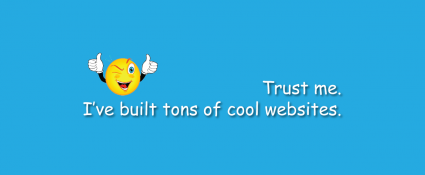
Less than 20 years ago, the Web was new. There were really no standards to speak of. The innovators of the world were quick to try their hand at HTML code.
In 1995, I coded my first website. To say the least, it wasn’t anything to get excited about. I was really excited when I figured out how to have a hover affect for a button. I realize now that, even by the standards of the day, it wasn’t even good enough to be called mediocre.
Even with the tools as effective as they are now, I am amazed how many bad websites I see. Most often, the evidence of a bad website isn’t obvious at first glance. Even with the great templates that are available and the ability to build websites without knowing a lick of code, web designers (both amateur and professional) forget key components to website.
For years, people have thought that the Web requires technical ability. To execute on a Web design, it does. But, in fact, it requires a higher level of business and marketing understanding. It requires the ability to look at how the website fits into the overall marketing strategy. This is the reason I wrote my book. Too many people are jumping in feet first into the world of design tactically and ignoring the strategy behind it.
I think there are some key indicators of a poor Web strategy. What’s amazing is how often I see many of these elements on my competitors’ websites, too. Take a moment to look at your website and see how you stack up with what’s expected.
These are in no particular order.
It’s not good enough to have a contact form that says, “Email me, I’ll get back to you.” Perhaps if you are an overstuffed organization, you might get away with it but people still want to talk to people. It’s bad enough if I have to browse to your contact page to find your contact info but if it’s not there at all, I hate you.
The fix: Put your phone number and address in the footer of every page. Your phone number in the header is even better.
2. Poor contrast.
When you have a dark background, you should have light text. When you have a light background, you should have dark text. Often, different sections of a website will have different colors of backgrounds. Each of the sections should be checked for contrast. In addition, your background should not compete with your text.
The fix: Make sure that all text on your website is high enough contrast to be able to read.
3. Inconsistent link colors.
The default color of a link in most Web browsers is a bright blue… with an underline. Often, designers want to choose a different color for the links. Too often, the links are changed in some areas of the website and not in others. It causes people to not know which is the link if there are different presentations of those links. In different areas on the page, it might be appropriate to have something different (e.g. the main menu links may look different than content area links). Also, too often, links aren’t differentiated enough from the body text so it’s hard to see where the link is.
The fix: Make sure that all links look like links and look like they belong to each other.
4. No clear call to action.
When we are selling to someone face-to-face, history has proven that when you are clear with your expectations, people are more likely to buy. Think of high school when a boy asks a girl on a date. If he asks, “Will you go out with me?” he’s much more likely to get a positive response than if he asks, “You don’t want to go out with me, do you?” When you don’t have a clear call to action, it’s like being timid in your question. If you want an email, ask for it. If you want them to read more, ask for it. Make it clear.
The fix: Decide your primary goal for your website and make the call to that action as clear as possible.
When you try to be all things to all people you end up being nothing to no one. You don’t need to demonstrate all the services you offer in the first visit. When you try to squeeze everything into your home page, people will not know what to focus on and you’ll end up losing more than gaining.
The fix: Focus on your core service offerings for key landing pages and let those interested in learning more dig deeper.
6. Blog and/or social media not maintained.
If you are going to have a blog or a social media presence, you had better maintain it. The prompting for this blog post was that I was doing some research on a competitor and found that their blog still has the default Wordpress blog that says, “Welcome to WordPress. This is your first post. Edit or delete it, then start blogging!” The site was built four months ago and it’s still like that. If you are going to put a link to these areas, you better use them.
The fix: Participate or get out. There is no halfway anymore.
This is when you have to scroll right to left to see the full page. This is harder to manage now because of the smaller screens of tablets and smart phones. But, it’s more important now than about anytime to have this under control. You might consider having a responsive mobile theme (usually my recommendation) or a separate mobile site. But, on standard browsers you should have no horizontal scroll… and turning off scroll bars for your site visitors is not good enough.
The fix: Get a designer that knows what he’s doing — as shown by experience not the regurgitation of platitudes.
8. Typography is not thought out.
Using the standard Web browser defaults for your type is not good enough. Each type of typography needs to be designed. The headers, paragraphs, links, bulleted lists, numbered lists, block quotes, etc. need to be addressed. With the ability to use more fonts now than in the past, unless the standard fonts meet with your brand identity, you should plan on using a newer font and look at each type of text to make it pretty.
The fix: Create a typography set that is fresh and appealing. Test it and test it again. Don’t settle.
9. Ugly logo and graphics.
As I quoted myself in my book, “Whenever I see an ugly logo I think, ‘The CEO must have designed that one.’” Why do we settle for mediocrity? Yes, quality imagery costs more, but not that much more. Don’t settle for the logo designer that charges you a couple hundred dollars. Don’t pick the stock photography that everyone else picks. I understand that Web designers sometimes are limited by the budgets of clients but if it’s your website, pony up a few extra dollars to do it right.
The fix: Get a logo that doesn’t suck. Spend a few dollars more on imagery.
10. No emotion.
Most websites are simply boring. They have no personality. They have no intrigue or interest. They are flat. Bloggers have an advantage here because their own personality can more easily show through. Helping people understand what you believe makes this much easier than showing them what you do. It’s a fine line and is the hardest to overcome but it’s probably the most critical.
The fix: Focus on your why. Focus on telling people what you believe and not what you do.











